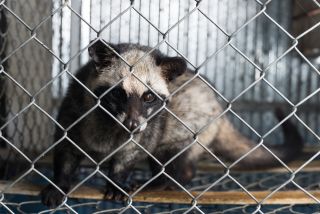Ethics and Morality
Exotic-Pet Keeping as a Form of Human Predation
An unsustainable practice with severe ethical and ecological reverberations.
Posted August 10, 2023 Reviewed by Michelle Quirk
Key points
- Although pet keeping is generally assumed to be a benign activity, there are darker sides to this practice.
- A new study finds that pet keeping is a significant form of human predation.
- Predatory interactions have a significant impact on the structure and functioning of ecosystems.

The practice of purchasing live animals to keep as pets has become prevalent worldwide, with millions of households acquiring animals each year for the purposes of companionship or entertainment. Although pet keeping is generally assumed to be a benign activity that simply adds happiness to the world, there are darker sides to the practice. A recent study published in Communications Biology titled "Humanity's diverse predatory niche and its ecological consequences" makes the startling claim that pet keeping is a significant form of human predation and highlights the ethical and ecological implications associated with this common practice.
Predation and its influence on ecosystems
The research, which was conducted by a group of conservation biologists, aims to estimate the extensive interactions between contemporary human predators and other vertebrates by quantifying humanity's predatory niche. As the authors note, the strength and diversity of predatory interactions have a significant impact on the structure and functioning of ecosystems, affecting species diversity, abundance, energy flows, and disease dynamics. With the rise of advanced hunting and fishing technology, global commercialization, and trade, human interactions with prey species have undergone profound changes and are driving significant shifts in biodiversity.
Unlike previous studies that have focused on specific taxa or areas of intense exploitation, this analysis encompasses all forms of predation and spans the planet's vertebrates. By collating data from the International Union for the Conservation of Nature (IUCN) on species exploitation and trade on 47,000 species, the researchers provide a comprehensive overview of human predation. Their analysis covers activities ranging from the pet trade to trophy hunting to medicine to commercial fishing, encompassing any use that removes individuals from wild populations.
Human exploitation of vertebrate species far exceeds that of other predators. Humans exploit up to 300 times more species than comparable nonhuman predators. We exploit nearly 15,000 vertebrate species for various food and nonfood uses, endangering many of these species and threatening their roles within ecosystems. Approximately 31 percent of the species across the six vertebrate classes examined are utilized by humans, with only about 17 percent of them being killed for food. The highest diversity of human prey species is found among marine prey (43 percent), followed by freshwater (35 percent) and terrestrial (26 percent) species. Ray-finned fishes and birds are the most extensively exploited, accounting for 78 percent of all exploited vertebrates.
Exploitation for the pet trade
How exactly is pet keeping a form of predation? We’re talking here specifically about exotic pets, which are typically defined as animals kept in captivity that are not commonly domesticated or found in the local environment. These animals are often selected for their unique appearance, behaviors, or characteristics that differ from traditional pets such as dogs, cats, or domesticated farm animals. Exotic pets can include a wide range of species, such as reptiles (e.g., snakes, lizards), amphibians (e.g., frogs, salamanders), birds (e.g., parrots, birds of prey), small mammals (e.g., ferrets, sugar gliders), and even some nontraditional insects and arachnids. Anytime a pet has been “sourced” from the wild, this counts as predation according to the metric established by the Nature study authors. And a lot of animals who become someone’s pet have come from the wild.
Although predation on marine and freshwater species is driven primarily for food use (72 percent of species), in the terrestrial realm, use as pets is almost twice as common (74 percent) as use for food (39 percent). In terms of geographical patterns of use, the researchers note that “Pet use accounts for more than half of exploited species across most of the terrestrial regions of the planet as well as in marine areas surrounding archipelagos.” Predation on animals for pets is not only common but now also poses “a key threat to endangered wildlife in many areas."
Ethical and ecological concerns of pet keeping
Pet keeping, as a significant aspect of human predation, raises serious ethical and ecological concerns, particularly because the practice does not help meet a genuine human need, as does the use of animals for food, but serves only as a form of entertainment. The demand for pets fuels the removal of individuals from wild populations, disrupting the delicate balance of ecosystems. The excessive exploitation of certain species for the pet trade threatens their survival and can lead to their extinction in the wild. Additionally, the trade in exotic pets often involves illegal activities such as wildlife trafficking, further exacerbating the ecological consequences.
The impact of the pet trade compared to food, agriculture, and hunting can vary depending on the specific context and region. However, studies have shown that the pet trade is a significant contributor to the exploitation of vertebrate species worldwide and is a strong driver of species and biodiversity loss. According to this study’s analysis of IUCN "use and trade" data for roughly 47,000 species, the pet trade accounts for more than half of the exploited species across most terrestrial regions of the planet and affects almost as many species as those targeted for food consumption.
The findings of this research highlight the unsustainable nature of pet keeping. The demand for pets has escalated over the past decade, putting additional pressure on already vulnerable species. Although some forms of human predation are essential to our survival, pet keeping serves no useful purpose. One of the key actions we can take to protect vulnerable species and ecosystems is not participating in pet keeping and discouraging others we know from participating. We can also support initiatives that discourage the capture and trade of wild animals for the pet industry.
What can you do today:
- Don’t be a pet predator. Don’t participate in this form of exploitation; don’t buy or keep exotic pets.
- Don’t shop at pet stores that sell live animals and tell them why you won’t shop there.
- Don’t “like” or share social media posts featuring exotic pets.
References
Darimont, C.T., Cooke, R., Bourbonnais, M.L. et al. Humanity’s diverse predatory niche and its ecological consequences. Commun Biol 6, 609 (2023). https://doi.org/10.1038/s42003-023-04940-w




